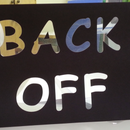Introduction: Easy, Inexpensive AND Accessible Stylus
Capacitive touch sensors appears in different forms. Many popular forms include screens on smartphones, tablets and switches. In order to activate these screens or switches, a conductive material need to come into close proximity. Many use their fingers for this purpose.
However, using a stylus instead of a finger with capacitive touch sensors is often preferred by people who may have BIG fingers or other physical limitations. Here, we share an easy and expensive way to make a stylus that may be used by people of different sizes and abilities.
To start, we need three materials:
1) 1 1/2" x 1 1/2" square piece of low-density, 1/4" thick conductive foam;
2) 2" piece of rubber of silicone self-adhesive tape (regular electrical tape will work, also);
3) 1 metal chopstick (many Asian grocery stores sell these and are sometimes known as Korean chopsticks).
Step 1: Putting Together the Basic Stylus
Notice the ends of the chopstick are of slightly different sizes. It doesn't matter which end is used for this step. HOWEVER, if you want to use Option 3) below (mouthstick stylus), use the thicker end in this step -- wrap the conductive foam around the thicker end! Otherwise, wrap the conductive foam around either end of the chopstick.
Step 2: Finishing the Basic Stylus
Wrap the tape around the base of the conductive foam. This is the tricky part if you are using either of the self-adhesive tapes! Stretch the self-adhesive tape so that the part that touches the chopstick is tightly wound. Don't worry if there is tape sticking out above (the foam). It can always be trimmed later. If you're using regular electrical tape, you'll notice that it doesn't stretch much, so tape the conductive foam as best you can. In our pictures, we used rubber self-adhesive tape which is a lot more cost effective than the silicone type.
Step 3: Option 1: Heavy-duty Tip:
For some drawing apps or programs, or for heavy-duty use, a thicker tip may be desired.
Addition materials for Option 1:
1) 1 pencil "cap" eraser;
2) 2 1/2" x 1 1/2" piece of low-density, 1/4" thick conductive foam INSTEAD OF THE 1 1/2" x 1 1/2" ABOVE.
For this, a pencil "cap" eraser that is made to fit to the end of a pencil may be inserted onto the thicker end of the chopstick before wrapping the conductive foam as in the Basic Stylus. Also, a larger piece of conductive foam will be used instead. Wrap the conductive foam tightly around the pencil eraser then secure it with a piece of self-adhesive or regular adhesive tape (as in the directions for the Basic Stylus).
Step 4: Option 2: Making It Easier to Hold:
For persons who find it difficult to hold or grasp the (narrow) chopstick, the Basic Stylus may be made easier to hold with a loop around the middle and a thicker area to grip.
Additional materials for Option 2:
1) 5" x 7" piece of puffy shelf-liner (these usually have small holes in them and look "checkered");
2) 3 pieces of 2" long self-adhesive or adhesive electrical tape;
3) 3 pieces of 4" long self-adhesive or adhesive electrical tape;
4) 18" of 1/4" refrigerator tubing.
The length of the refrigerator tubing may be trimmed to be long enough to wrap around the user's hand one and a half times. To secure the loop, it is usually easiest to tape the middle of the loop down first than the sides. Tape down the middle of the loop with a 2" long piece of tape.
Once the loop is secured, roll the puffy shelf-liner around the tubing and chopstick, again taping down the middle first with a 4" long piece of tape. Finish by securing the sides with 4" long pieces of tape.











